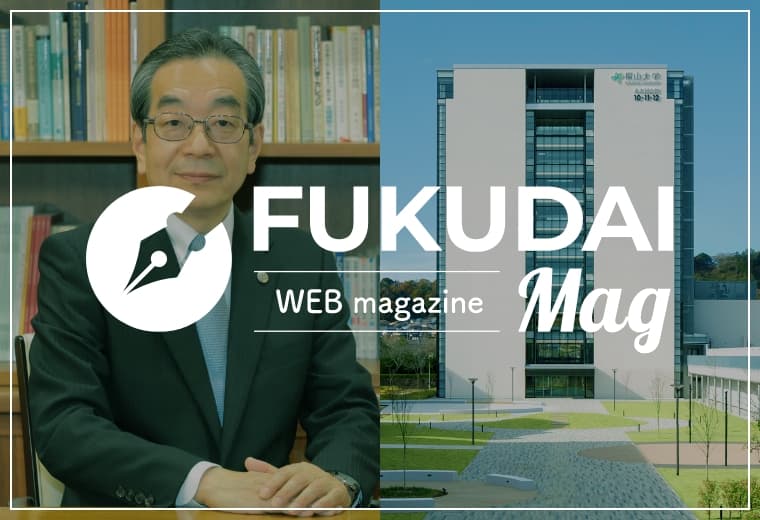Fukuyama University was born here in the “Sanzo Hills” of the Bingo region in 1975, starting with only two faculties consisting of three departments. The founding spirit in its establishment includes three key tenets: to emphasize the unity of knowing and doing, to respect humanity, and to carry out education that promotes all-round development including harmonious character-building. These are achieved with the university being widely open and accessible to the community. Fukuyama University has nowadays grown into the only comprehensive university in the eastern part of Hiroshima Prefecture with five faculties consisting of fourteen departments ranging from humanities and social sciences through to science and technology and medical sciences. It is based on the founding spirit that led to the establishment of Fukuyama University. It aims to bring up the “Future Creators” who value the region, who are loved by the region, and who can connect the region with the rest of the world. Fukuyama University recently completed the construction of a symbolic new school building named the “Future Creation Hall” and is “moving steadily forward.” Fukuyama University’s brilliant achievement appears vividly in the employment rate of the graduates reaching almost 100% every year. This far exceeds the average rate of the whole nation as well as that of Hiroshima Prefecture.
For the young people who live in a rapidly changing society in “unpredictable times”, the learning in a university should prepare them with “the ability to keep on studying” and to find the best solution to “questions with a variety of potential answers” no matter what the circumstances. Moreover, it must serve as a base to thrive in the next era. Fukuyama University aims to forge an original academic structure of the institution as a whole. It created the so-called “Fukuyama University Education System” and has made constant revisions and improvements according to the changes and needs of the society. Especially at the time of the 40th anniversary of the university in 2015, the diploma policy (the criteria of graduation authorization and degree conferment) was defined anew, and the curriculum policy (curriculum design and its implementation guidelines) was also drawn up towards the realization of the “Education System” in each faculty and department.
The “Education System,” which can be summarized as a goal-based type of system that respects the construction of human relations, has the following features. Firstly, the minimum standards for graduation (the largest-level target) within every department, must be obtained by every student at the time of graduation. These are specified over the three domains of knowledge, skill, and attitude. These are then followed by the medium-level targets in each domain which are in turn followed by the smallest-level targets for all courses or classes directly connected with the above-defined targets. The whole system, which progresses from the smallest to medium and then to the largest targets, is visualized as a “curriculum map.” It is emphasized here that “what teachers teach” is less important, and “what students will be able to do” is more important. In addition, based on the idea that “the willingness to study is born in the human relations of strong bonds”, four steps are set up from the entrance to graduation. These are: (1) independence as a university student, (2) dialog with friends and self-discovery, (3) participation in community activities, and (4) self-realization in the society. Furthermore, how well the predetermined targets have been achieved is “rendered visible” in radar charts at the individual, departmental, and whole institutional levels.
It is believed that the three major functions of a university consist of education, research, and social services. Although the issue of integrating research and education involves various arguments, it is difficult to consider a university education without research. Taking advantage of a comprehensive university covering a wide range of disciplines, both in sciences and liberal arts, we have been tackling a variety of unique research projects. These are named the study of “the Satoyama (mountains near the town) and Satoumi (coastal areas where biological productivity and biodiversity has increased through human interaction) of the Seto Inland Sea.” It was selected and subsidized for the private university branding research projects in the 2017 academic year by the Ministry of Education, Culture, Sports, Science and Technology (MEXT). A variety of community-based research has been initiated to investigate many aspects of the Bingo region. Some of the exciting research subjects include examining the peculiar ecosystem of the multi-island environment of the Inland Sea, exploring the rich marine resources, understanding the many unique companies in the Fukuyama area, and investigating the cultural heritages of Tomonoura and Kannabe, etc. The research activities, which contribute to the development of local industry and culture, are also prosperous. Some examples include the newly developed aquaculture technology of breeding a larger-size of sillagos, the production of university brand wine, and other foods using yeasts isolated from roses, the city flower of Fukuyama, etc. Students are also involved in these research projects and thus they have formed a platform for active learning.
Now, let’s move steadily forward together toward the realization of your future dream here in Fukuyama University, which is rooted in this area. We, all teachers and staff, are ready to do our best to support you.





学長3-510x340.jpg)
